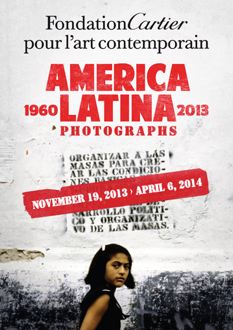
November 19 - April 6, 2013
Carlos Garaicoa
AMERICA LATINA, 1960–2013
Fondation Cartier, Paris
From November 19, 2013 to April 6, 2014, the Fondation Cartier pour l’art contemporain will present América Latina 1960-2013, coproduced with the Museo Amparo in Puebla (Mexico). The exhibition will offer a new perspective on Latin American photography from 1960 to today, focusing on the relationship between text and the photographic image.
Bringing together more than seventy artists from eleven different countries, it reveals the great diversity of photographic practices by presenting the work of documentary photographers as well as that of contemporary artists who appropriate the medium in different ways.
This unique presentation will provide the visitor with the opportunity to delve into the history of the region and to rediscover the works of major artists rarely exhibited in Europe.
Latin America : a Fascinating Region.
Over centuries, Latin America has fascinated observers as much as it has mystified them; there is a sense of the exotic that derives perhaps from it having once been perceived as a “new world.” Today, while contemporary Latin American culture has received much attention, the historical circumstances surrounding its production are often less widely explored.
The exhibition América Latina will cover the period from 1960 – the year following the Cuban revolution – to today. In many Latin American countries, this period has been marked by political and economic instability, and has seen a succession of revolutionary movements and repressive military regimes, the emergence of guerilla movements as well as transitions toward democracy. By exploring the interaction between text and image in the art of Latin America over the course of the last fifty years, the exhibition provides a vivid look into this tumultuous period of history through the eyes of the artists.
Photography and Text in a Shifting World
During the era covered by the exhibition, when the climate of political upheaval required an urgent response, many Latin American artists increasingly sought to escape media specificity by bringing text and image together in their work. This new visual approach provided them with an effective tool for expressing themselves and communicating, as photography is a medium that rapidly and realistically records reality while text provides a way of expanding or altering the meaning of the image. Through these formalistic inventions the artists tried to portray the complexity and violence of the world around them and in some cases to sidestep censorship. In the 1980s the Chilean artist Eugenio Dittborn created ‘‘airmail paintings’’ which were folded up and sent all over the world, circumventing Chile’s cultural isolation under Pinochet. As for Miguel Rio Branco, a figurehead of Brazilian photography, he has depicted the underclass of a two-tiered society in a highly poetic manner.
ARTISTS
Elías ADASME (Chili), Carlos ALTAMIRANO (Chili), Francis ALŸS (Mexique), Claudia ANDUJAR (Brésil), Antonio Manuel (Brésil), Ever ASTUDILLO (Colombie), Artur BARRIO (Brésil), Luz María BEDOYA (Pérou), Iñaki BONILLAS (Mexique), Oscar BONY (Argentine), Barbara BRÄNDLI (Venezuela), Marcelo BRODSKY (Argentine), Miguel CALDERÓN (Mexique), Johanna CALLE (Colombie), Luis CAMNITZER (Uruguay), Bill CARO (Pérou), Graciela CARNEVALE et le Grupo de Artistas de Vanguardia (Argentine), Fredi CASCO (Paraguay), Guillermo DEISLER (Chili), Eugenio DITTBORN (Chili), Juan Manuel ECHAVARRÍA (Colombie), Eduardo Rubén (Cuba), Felipe EHRENBERG (Mexique), Robert FANTOZZI (Pérou), León FERRARI (Argentine), José A. FIGUEROA (Cuba), Flavia GANDOLFO (Pérou), Carlos GARAICOA (Cuba), Paolo GASPARINI (Venezuela), Anna Bella GEIGER (Brésil), Carlos GINZBURG (Argentine), Daniel GONZÁLEZ (Venezuela), Jonathan HERNÁNDEZ (Mexique), Graciela ITURBIDE (Mexique), Guillermo IUSO (Argentine), Alejandro JODOROWSKY (Chili), Claudia JOSKOWICZ (Bolivie), Marcos KURTYCZ (Mexique), Suwon LEE (Venezuela), Adriana LESTIDO (Argentine),Marcos LÓPEZ (Argentine), Pablo LÓPEZ LUZ (Mexique), Rosario LÓPEZ PARRA (Colombie), LOST ART (Brésil), Jorge MACCHI (Argentine), Teresa MARGOLLES (Mexique), Agustín MARTÍNEZ CASTRO (Mexique), Marcelo MONTECINO (Chili), Oscar MUÑOZ (Colombie), Helio OITICICA (Brésil), Damián ORTEGA (Mexique), Pablo ORTIZ MONASTERIO (Mexique), Leticia PARENTE (Brésil), Luis PAZOS (Chili), Claudio PERNA (Venezuela), Rosângela RENNÓ (Brésil), Miguel RIO BRANCO (Brésil), Herbert RODRÍGUEZ (Pérou), Juan Carlos ROMERO (Argentine), Lotty ROSENFELD (Chili), Graciela SACCO (Argentine), Maruch SÁNTIZ GÓMEZ (Mexique), Vladimir SERSA (Venezuela), Regina SILVEIRA (Brésil), Milagros DE LA TORRE (Pérou), Susana TORRES (Pérou), Sergio TRUJILLO DÁVILA (Colombie), Jorge VALL (Venezuela), Leonora VICUÑA (Chili), Eduardo VILLANES (Pérou), Luiz ZERBINI (Brésil), Facundo DE ZUIVIRÍA (Argentine)
